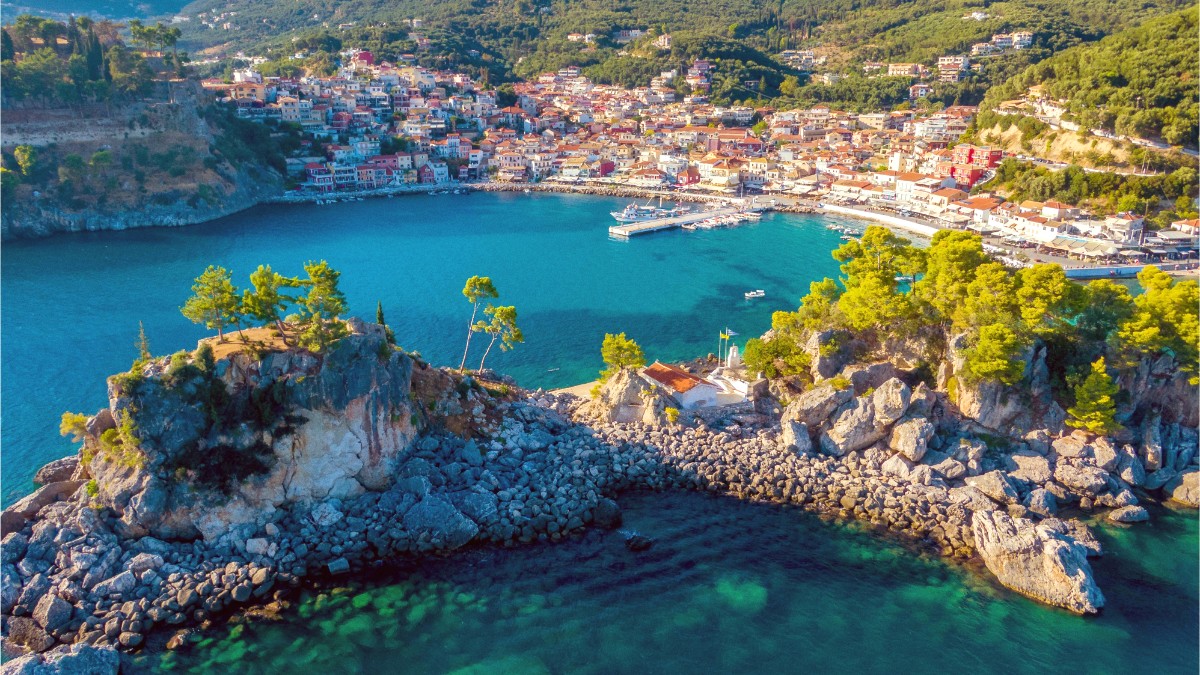
Greece
Greek food reflects a long history, with ancient traditions, Byzantine Empire, and centuries of Ottoman and Venetian rule. Parga's Ionian coast location means seafood plays a big part in its dishes, alongside classic meat-based meals. Abundant olive oil, fresh vegetables, and wild herbs define the flavors.
The foundation of Parga's cuisine rests on fresh, high-quality ingredients. Feta cheese, a staple, features in many dishes and salads. Herbs like oregano, mint, and thyme add aromatic notes, while garlic and fresh lemon juice brighten many flavors.
Generally a light meal, often just coffee and a pastry, consumed between 8:00 AM and 10:00 AM. Hotels serve more substantial breakfasts.
This can be a lighter or more substantial meal, usually eaten between 1:00 PM and 3:00 PM. Many local businesses close for a mid-afternoon break.
The main meal of the day, typically eaten late, starting from 8:00 PM and extending until 11:00 PM or later, especially in the summer months. Restaurants often open for dinner around 7:00 PM.
Given Parga's coastal location, fresh grilled octopus, calamari, and various fresh fish (like sea bass, bream, red mullet, or swordfish) are highlights. Fish is often simply grilled with olive oil, lemon, and herbs.
Find it: Any taverna by the sea or in the port area.
Souvlaki: Grilled skewers of pork or chicken, often in pita with tzatziki, tomato, onion, fries. Gyros: Shaved seasoned meat (pork/chicken) from a rotisserie, in pita with similar toppings. Quick, flavorful, inexpensive meals.
Find it: Widely available at fast-food eateries and souvlaki shops.
Tzatziki: Refreshing dip with strained Greek yogurt, cucumber, garlic, olive oil. Saganaki: Pan-fried cheese dish, often graviera or kefalotyri, sizzling with lemon. Delightful appetizers.
Find it: Served everywhere (Tzatziki), most traditional tavernas (Saganaki).
Ouzo (anise-flavored aperitif), Tsipouro/Raki (strong, clear spirit), Greek Coffee (strong, unfiltered), Frappe (iced instant coffee), Local Wine (house wine by carafe).
Loukoumades (fried dough with honey), Baklava (filo pastry with nuts and syrup), Greek Yogurt with Honey (creamy strained yogurt with local honey).
Parga has a select number of upscale restaurants, often with refined ambiance, attentive service, and elevated menus. These establishments offer modern Greek cuisine or international dishes with local ingredients.
These are abundant throughout Parga, forming the backbone of its dining scene. They offer traditional Greek taverna fare, fresh seafood, grilled meats, and classic cooked dishes (magirefta).
For quick, affordable, and delicious meals, Parga has many options. The growing international tourist base means you find a limited but increasing number of restaurants offering international dishes.
Parga has a small local market where you find fresh produce, fruits, and some local products. Exploring it brings insight into local life and offers ingredients for self-catering.
Not a large food hall like in major cities.
Larger supermarkets (e.g., AB Vassilopoulos, plus smaller local ones) give a full range of groceries.
Useful for self-catering accommodations.
Dine at a traditional taverna a few streets back from the main promenade for authentic local flavors and good value.
Seek restaurants positioned high on the hillside for breathtaking panoramic views of Parga and the sea, especially at sunset.
During high season, reservations are recommended for fine dining establishments or popular mid-range restaurants.
Ask your accommodation or local shopkeepers for their favorite tavernas for authentic, unadvertised experiences.
Halal and Kosher certified food options are generally not widely available or advertised in Parga. Muslim and Jewish travelers may seek out vegetarian, fish, or plant-based dishes, and confirm preparation methods.
Dedicated Halal/Kosher butchers or restaurants are rare.
Awareness of gluten-free and other allergens is growing in Greece. Many naturally gluten-free dishes exist (grilled meats/fish, salads). Bread is everywhere; explicitly decline it if needed.
It is advisable to carry a small card translated into Greek explaining your specific dietary restrictions.
"Έχω δυσανεξία στη γλουτένη" (Ekho dysanexía sti glouténi) - I have gluten intolerance.
When dining with specific dietary needs, carry a small card translated into Greek explaining your restrictions. This creates clear communication.
While formal cooking classes are not a main feature, some local guesthouses or specialized tour operators might offer informal cooking demonstrations. These instances provide insights into local culinary traditions.
The area surrounding Parga is rich in olive groves. Some olive oil producers or family-run farms may offer tours of their groves and olive presses. These tours often culminate in an olive oil tasting.
Dining with a view is a quintessential Parga experience. Many restaurants are built into the hillside, displaying breathtaking panoramic vistas of the Venetian Castle, the town, Panagia islet, and the Ionian Sea.
Formal, regularly scheduled cooking classes are not as common in Parga as in larger Greek cities. Inquire locally upon arrival if any opportunities are available.
This applies to farm visits and food producer tours as well.
Another unique experience is dining at tavernas directly on the beaches like Valtos or Lichnos, with the sound of waves providing a relaxing backdrop.
These locations offer a different kind of calm and enjoyment.
Visit local olive oil producers to learn about the process and taste fresh, high-quality local products.
During Easter, find magiritsa and roasted lamb. Christmas features kourabiedes and melomakarona. Check local calendars for event details.
Explore the small local market for fresh produce, fruits, and insights into local life.
Tavernas by the port or along the waterfront often display their daily catch for you to choose from.